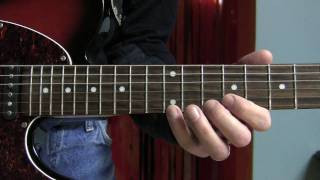How to Improvise over Summertime using Scales
Published on 26 January 2016
For more information from the source site of this video please visit: http://secretguitarteacher.com/youtube/intermediate/jazz/JeQmTTSs5mA/91778026-how-to-improvise-over-summertime-using-scales.php
This lesson is a sample from the Secret Guitar Teacher website (see link above).
It is for Intermediate players and comes from the Intermediate level course called: 'From Blues to Jazz'.
Here's the abridged transcript:
Ideas for improvising can then be gleaned from both the underlying chord sequence and the melody.
Let's use this song to demonstrate a couple of nice simple approaches to improvising. These work particularly well with a song like this that has plenty of space between the melodic lines. We are simply going to start by playing the lines of the melody and using scales to fill in the gaps in between.
Because the song is basically in a minor key let's start by experimenting with using the Natural Minor scale. Here's the first position Natural Minor scale. pattern:
In A minor we'd want to start that at the 5th fret. As all but one of the notes from the melody lie on this scale, we can use this as a fairly safe set of notes to fall back on.
But it's also a good idea to have a second scale up your sleeve that perhaps provides some contrast. A good example of a reliable contrasting scale for the natural minor is the Harmonic minor scale. As you can see from the formula, it's only one note different from the natural minor scale, but that difference is surprisingly strong in its effect.
So let's have a go at using these scales to provide a bit of filling in between the melody lines. Here's how I might use the Natural minor scale in this way.
If we take the same approach with the Harmonic minor scale I think you'll hear we get a slightly stronger contrast between the melodic parts of the solo and the fills in between.
As well as these classical scales, because the melody contains the Eb note, the flatted 5th in the key of A minor, we can also throw in bits of the A blues scale.
Now let's look at an approach that will perhaps add more of a jazzy flavour to our solo. Let's take the simplest of the minor scales, the pentatonic minor, and chromaticize it.
To do this we take the outline of the scale:...and then simply fill in the gaps.
So we are linking some of the notes of the scale chromatically - that is using the notes from the Chromatic scale, the scale that includes all available notes.
Now the important thing with this is to make sure that, for the most part, you put the rhythmic weight on the scale notes.Notice, it doesn't always sound quite so good when I end rhythmic phrases on the notes in between the scale notes.
So, there are a few ideas about how to improvise over Summertime - or pretty much any minor blues tune - using scales. However, most Jazz guitar improvising focuses in more on chords than on scales and, although this is harder work, I want to use the next lesson to gently introduce some chord-based approaches to Jazz improvising.
Look forward to seeing you then, meanwhile lets play out with a jam against the backing track using all the ideas mentioned in this lesson.
 Eric Clapton Blues Guitar Lesson Pt 3
Eric Clapton Blues Guitar Lesson Pt 3
 46 - 4 Note Arpeggio Positions in C Major - Slowly
46 - 4 Note Arpeggio Positions in C Major - Slowly
 Tone Lab 11 - Fender Relic Strat
Tone Lab 11 - Fender Relic Strat
 Open G Tuning, Guitar Lesson, Slide Guitar, Blues,...
Open G Tuning, Guitar Lesson, Slide Guitar, Blues,...
 John Mayer Slow Blues Lick Lesson
John Mayer Slow Blues Lick Lesson
 Blues lick BB King style
Blues lick BB King style
 Slow Blues Guitar Lesson
Slow Blues Guitar Lesson
 3 Easy Guitar Licks Anyone Can Play!
3 Easy Guitar Licks Anyone Can Play!
 A Simple Approach to a Complicated Texas Blues Rhy...
A Simple Approach to a Complicated Texas Blues Rhy...
![How To Play Turnarounds - Blues Rhythm Guitar Lessons [BL-209]](https://guitarious.com/storage/videos/3339/bTVAFfbkKqU.jpg) How To Play Turnarounds - Blues Rhythm Guitar Less...
How To Play Turnarounds - Blues Rhythm Guitar Less...







